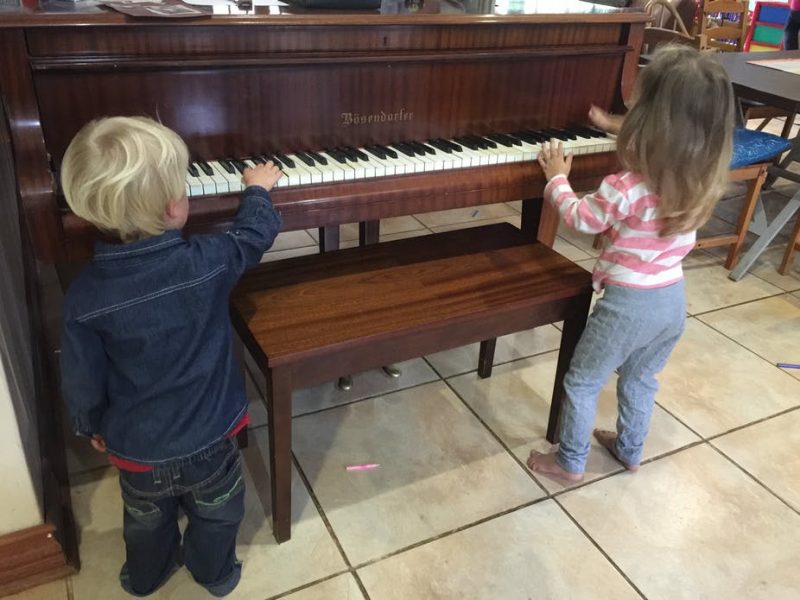When children sing and play, they’re also becoming scientific explorers
Young children engage in scientific thinking and actions long before they enter a classroom. They do all sorts of things in their pursuit of knowledge: poking, pulling, tasting, pounding, shaking and experimenting. This demonstrates their need to learn and naturally seek out problems to solve.
That’s why creating opportunities for observations and actions through play could stimulate children’s emerging scientific thinking. Play offers a valuable way to help children learn basic scientific literacy. That’s because artistic expression is a natural part of early childhood.
In a recently published study I explored whether there could be a rationale for music-inspired free play to foster scientific exploration in early childhood. As part of my research, I watched preschoolers during free play at two daycare centres in Mohadin in South Africa’s North-West province.
Free musical play takes place in an environment that has been prepared by the teacher (though children themselves take the initiative for playing). The space stimulates the young child to experiment with and explore the musical properties of sound.
I specifically focused on music-inspired play because music in early childhood is one of the first natural and accessible “tools” for children to express their thoughts, feelings and desires. Musical and artistic activity are especially important at an early age; they nurture the development of emotion, imagination, creativity and gross motor skills.
Not only is children’s innate musicality expressed and developed when they are given the time to explore: it also creates freedom, flexibility and facilitation in the early years and gives rise to unexpected moments when learners integrate music into their own learning, especially through play, to explore their scientific world.
Through this work, I was able to develop a model that illustrates the rationale for music-inspired play to foster scientific exploration which teachers in early childhood settings could apply if they want to use musical freeplay to boost children’s scientific learning.
How play teaches
There is a difference between scientific thinking and the learning of scientific facts.
Scientific thinking involves children in the process of finding out, leading them to make their own discoveries. Teachers can foster scientific thinking by viewing young children as active learners rather than simply as recipients of knowledge. They can offer varied opportunities to explore and experiment, which will allow children to construct meaning and develop understandings that are not only valid but also valuable in their ongoing intellectual development.
For example, pre-schoolers can learn about the scientific concept of momentum by rhythmically moving on swings – while singing at the same time. As the swing gains momentum, singing becomes faster to match the speed of the learners’ movements. When learners slow down, sing the song at a slower tempo and stop moving their legs, the swing also slows down until it eventually stops.
Young children can also learn about how sound production works by using their voices and vocal chords, which vibrate to produce different sounds.
This sort of voluntary learning helps to reduce the consequences of failure. Children feel less frustrated and are allowed to be creative and expressive in spaces where they make choices.
It’s very important that teachers get involved in free play. Merely playing with no guidance won’t necessarily promote the desired learning. Teacher involvement does not mean that the teacher directs, interferes with or facilitates free play and exploration. But they can create appropriate environments, present opportunities and equip learners with musical experiences, knowledge and skills that can be used during free play.
This allows teachers to extend their learners’ knowledge. They can also model skills and strategies for turning experiences in free play into learning.
And musical free play doesn’t just have to take place outside, on a playground. It can also happen during class: for instance, when children tap rhythms with their pencils on desks while waiting for time to pass as a teacher hands out books.
A model for learning
I drew from previous research for the bulk of my study. This was supplemented by observations at two rural preschools.
By watching the children at these schools during recess and in class, I was able to identify and explore practical examples of music–science relationships during free play.
The children at both preschools produced a variety of spontaneous musical sounds, phrases and chants to accompany their play. Some children commented to me about sound production, describing how they experienced this scientific concept through music-inspired role-play – pretending to be other people or famous actors.
One outspoken boy informed me that his tonsils had been removed and that this operation influenced what his voice sounded like when he copied other people’s singing. Before the tonsillectomy, his tone of voice was much higher. Afterwards he found it easier to copy people with lower voices with a raspy tone.
I then created a model that encourages early childhood educators to create opportunities for constructivist learning to take place through reflection and exploration in free play. The idea is that once pre-schoolers are exposed to musical experiences, these can be integrated into their free play to foster scientific exploration.
Constructivism, as academic Joseph Shively explained it, is “how we make meaning of our experiences and come to know the world”. I adapted this to explain how children make meaning of musical experiences and come to know the world through scientific exploration.
In the model, facilitation of and exposure to musical skills, experiences and knowledge is the first step. Learners are then able to use these musical skills, activities and knowledge in their free play in an interesting and rich environment created by an encouraging, responsive teacher, which could in turn foster scientific exploration.
Central photo: Musical expression can help kids develop scientific thinking. Mignon Van Vreden
